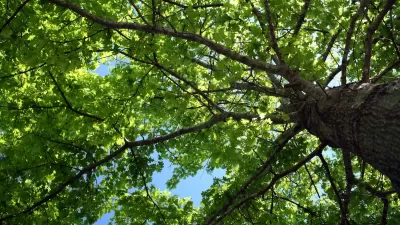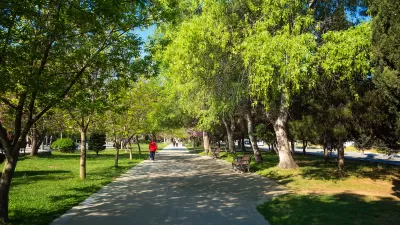A robust tree canopy can help reduce the urban heat island effect and lower air temperatures, but the impact is reduced as temperatures rise.

A new study from the University of New South Wales reveals that the ability of trees to combat overheating is reduced in extremely hot temperatures. “The findings, published in Sustainable Cities and Society, opens in a new window, show that conventional climate models overestimated the ability of trees to cool during heat waves by 60 per cent.”
The study poses a serious problem for cities relying on planting trees as a key part of their heat mitigation strategy. “It’s not to say that tree planting initiatives aren’t important for heat mitigation, but that large-scale planting policies require careful consideration,” said one of the study’s co-authors, Professor Mattheos (Mat) Santamouris.
As Ben Knight explains in the article, trees typically reduce surrounding air temperatures by 1 to 2 degrees Celsius in the daytime by releasing vapor through their leaves and absorbing heat. In high heat conditions, trees limit their transpiration, a factor not accounted for in current climate forecasts.
In the study’s sample of eucalyptus trees in Sydney, two-thirds of the trees were overestimated in their cooling ability during extreme heat by 60 percent. “Prof. Santamouris says decision-makers need to be more selective about the types of trees used and their various temperature thresholds. Under extreme temperatures, trees can also emit high concentrations of Biogenic Volatile Organic Compounds (BVOCs) like Isoprene, which can harm air quality when they interact with other atmospheric pollutants.”
Santamouris also warns that urban trees need adequate irrigation to provide optimal cooling benefits.
FULL STORY: Trees may not cool cities during heat waves as much as we thought

Alabama: Trump Terminates Settlements for Black Communities Harmed By Raw Sewage
Trump deemed the landmark civil rights agreement “illegal DEI and environmental justice policy.”

Planetizen Federal Action Tracker
A weekly monitor of how Trump’s orders and actions are impacting planners and planning in America.

Why Should We Subsidize Public Transportation?
Many public transit agencies face financial stress due to rising costs, declining fare revenue, and declining subsidies. Transit advocates must provide a strong business case for increasing public transit funding.

Understanding Road Diets
An explainer from Momentum highlights the advantages of reducing vehicle lanes in favor of more bike, transit, and pedestrian infrastructure.

New California Law Regulates Warehouse Pollution
A new law tightens building and emissions regulations for large distribution warehouses to mitigate air pollution and traffic in surrounding communities.

Phoenix Announces Opening Date for Light Rail Extension
The South Central extension will connect South Phoenix to downtown and other major hubs starting on June 7.
Urban Design for Planners 1: Software Tools
This six-course series explores essential urban design concepts using open source software and equips planners with the tools they need to participate fully in the urban design process.
Planning for Universal Design
Learn the tools for implementing Universal Design in planning regulations.
Caltrans
Smith Gee Studio
Institute for Housing and Urban Development Studies (IHS)
City of Grandview
Harvard GSD Executive Education
Toledo-Lucas County Plan Commissions
Salt Lake City
NYU Wagner Graduate School of Public Service





























